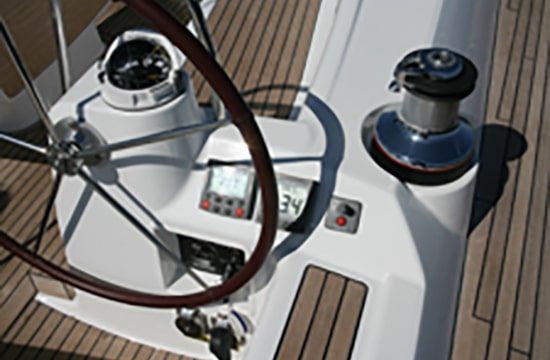Docking Maneuvers with Dual Rudders
There is no ability to spring the boat onto or off the dock! You have no water velocity over the rudders from either boat velocity or propwash. The best you have is minimal force differentials – but not much and nothing that will overcome any wind greater than a few knots. Therefore, you must plan your exit and docking based on the wind direction.
Exit Plan
On a Tee-head dock
Wind from ahead.
Plan: Push the bow out into the wind. Once clear, drive the boat out.
Execution: Release forward dock lines and push out. Climb aboard at the stern after releasing the stern dock lines.
Wind from behind
Plan: Push the stern out into the wind. Once clear, reverse the boat out.
Execution: Release aft dockline and push stern out. Climb aboard at the bow. Crewmate stands at bow and holds a dockside cleated line cleated at about midships. Helms person -slow reverse. Crewmate pulls on dockside line to keep the bow close to the dock while the stern clears outward. Once clear, continue to reverse the boat out.
Wind onto the dock
Potentially very difficult in high wind to get either the stern or the bow out. Use lots of fenders just in case.
Plan A: Get bow out using windward aft boat cleat to aft of stern dock cleat. Motor forward.
Plan B: Use midships cleat and forward gear to get the stern out. Then back out.
Wind off the dock
Easy Peasy!
Plan: Let the wind do the work. Push the bow out. Drive out forward once the bow clears.
Execution: Release bow line. Push the bow out. Climb about at stern. Once the bow is clear release the stern line and motor out.
Docking
On a Tee-head dock
The thought process is to get one line attached to the dock so that the boat can sit stable until the other lines can be attached. Engine power can be used which will create some minimal turning force. But the turning force is easily overpowered by the wind so some planning as to which approach is crucial.
Wind from Forward
Dive the bow to the dock at a 45-degree angle. Crewmate lassos the forward dock cleat and ties off to the boat’s forward cleat. At this point, the boat is safe as the wind is blowing the boat along the dock. Nothing much can happen. Helms person applies reverse. This will act to slowly bring the stern towards the dock allowing the stern and midship lines to be attached.
Wind blowing off the dock
Tie a long line from midships cleat and back to the midships cleat. The loop created should reach to about 6 feet (2m) past the stern and back. Dog-ear temporarily tie/stow the loop to the stern rail. Reverse the boat to the dockside stern cleat. Lasso the dockside stern cleat. Drive the boat slowly forward.
You can also use this midship cleat approach motoring forward. Here we are using this technique with a crew member. The midship cleat and forward gear keep the boat at the dock while the wind tries to push you off.
Wind from Aft
Tie a stern line to the aft cleat. Back the boat at an angle to the dockside stern cleat and lasso it with your prepared stern line, tie off. Ease the throttle in forward gear. The boat should come alongside.
Don’t believe us eh? See this
Wind blowing you onto the dock
Use the Wind from aft technique.
Exercises
Depending on your wind direction situation of the day and your practice marina setup, plan as many exercises as possible to achieve the following:
DR-5: Wind from forward or onto the dock
Forward to the dock. Cleat Bow first then use reverse gear.
DR-6: Wind blowing you off the dock
Reverse to the dock. Cleat midships on the boat with a long loop aft to the dock. Then use forward gear.
DR-7: Wind from aft or onto the dock
Reverse to the dock. Cleat aft first then use forward gear.
Giant Suggestion – Use our Virtual Reality Training course to create and practice all the scenarios as many times as you like.






